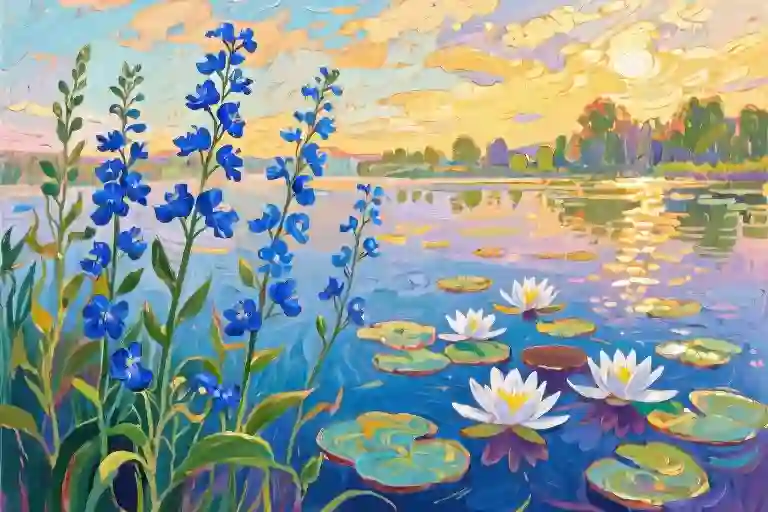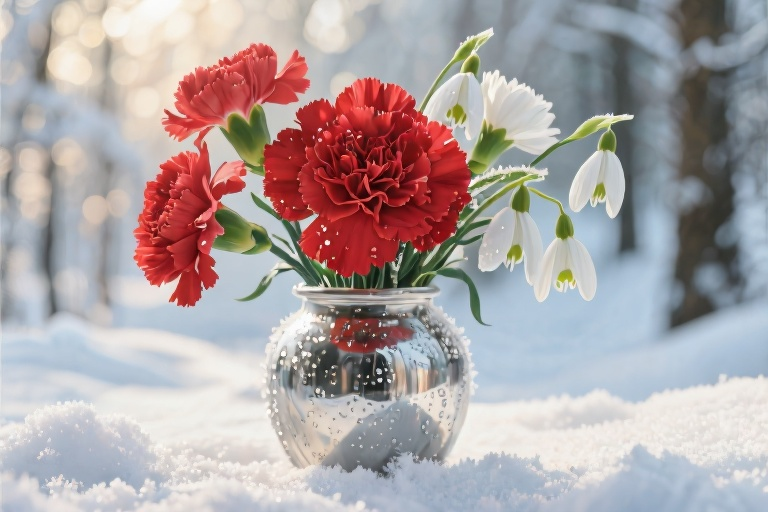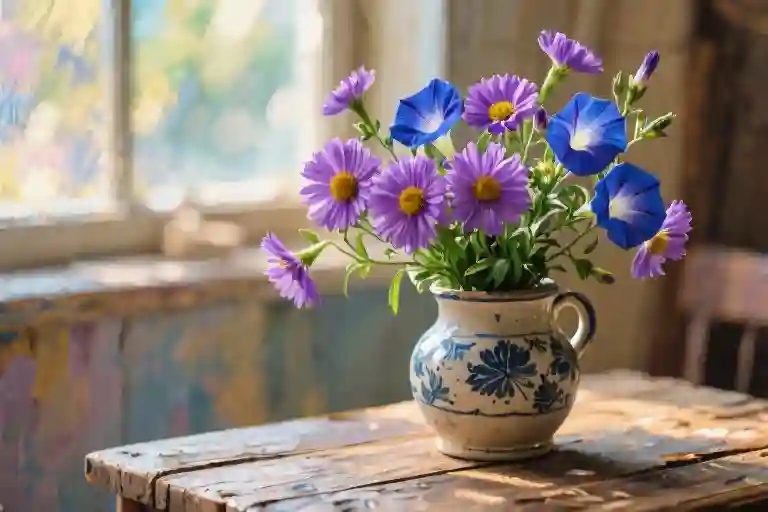July arrives with its sweltering days and languid evenings, a month that somehow contains both the year’s most vibrant energy and its deepest tranquility. It’s only fitting that nature would choose two such contrasting ambassadors to represent this paradoxical time: the bold, skyward-reaching larkspur and the serene, water-gazing lily. These July birth flowers don’t just share a calendar month—they embody the full spectrum of what summer means.
There’s something wonderfully democratic about July’s floral duality. While other months content themselves with single representatives, July insists on giving us options. The larkspur stands tall like a herald’s trumpet announcing summer’s peak, its clustered blooms vibrating with the same electric energy as heat lightning on the horizon. Meanwhile, the water lily floats undisturbed in its liquid world, proving that even in summer’s intensity, pockets of cool reflection persist.
This pairing makes perfect sense when you consider how we actually experience July. Some days demand the larkspur’s exuberance—its candy-colored spikes mirroring fireworks against twilight skies. Other moments call for the lily’s contemplative stillness, its circular leaves creating perfect islands of shade in sun-dappled ponds. Together, they form a complete portrait of the season’s rhythm: activity and rest, sunshine and shadow, celebration and introspection.
What’s particularly fascinating is how these flowers achieve their effects through opposite strategies. Larkspurs grow as terrestrial sentinels, their roots gripping earth while their flower spikes challenge the heavens. Water lilies exist in liquid suspension, their roots submerged but their blooms opening upward like aquatic stars. One pushes skyward from solid ground; one floats serenely between two worlds. Yet both have become equally powerful symbols of July’s essence.
Over the following sections, we’ll explore how each flower developed its unique relationship with this summer month. We’ll decode their secret floral languages—why larkspurs became emblems of ardent attachment while water lilies symbolized spiritual awakening. There are horticultural surprises too: the larkspur’s surprisingly toxic nature hiding behind its cheerful colors, the water lily’s ingenious biological adaptations that fascinated both scientists and artists. Most importantly, we’ll discover how to harness their distinct energies in our own lives, whether through gifting, gardening, or simply appreciating their seasonal wisdom.
For now, simply notice how these floral counterparts frame July’s contradictions. The next time you see larkspurs dancing in a breeze or lilies basking on a pond’s surface, you’re witnessing nature’s perfect solution to representing summer’s dual nature—not through compromise, but through celebration of opposites.
July’s Floral Duality: Earth and Water in Harmony
July’s birth flowers present a striking contrast that mirrors the month’s own character—where scorching afternoons give way to tranquil evenings. The larkspur stands tall like a sentinel on dry land, its spires reaching ambitiously toward the sun, while the water lily floats serenely, embracing the reflective nature of its aquatic home. These two floral ambassadors don’t compete but rather complete each other, offering alternative interpretations of midsummer’s essence.
Rooted vs Floating
Larkspurs anchor themselves firmly in well-drained soil, their hollow stems growing up to six feet tall with palmate leaves that resemble outstretched hands. Their vertical growth pattern creates natural exclamation points in gardens. Water lilies, conversely, exist in a weightless realm—their round leaves (sometimes spanning twelve inches) resting on water surfaces while submerged stems tether them to muddy bottoms. The lily’s ability to regulate buoyancy through specialized air channels in its petioles remains one of nature’s quiet marvels.
Pollination Strategies
These ecological differences shape their reproductive approaches. Larkspurs evolved to attract bees and hummingbirds with their upward-facing blooms containing nectar spurs—the curved protrusions that inspired their name (resembling a lark’s hind claw). Water lilies employ a more theatrical method: their flowers rise from the water each morning, exposing bright yellow stamens to beetles and flies, then gradually submerge in late afternoon to complete pollination underwater.
Native Habitats Tell the Story
Originally from the temperate meadows of Europe and North America, larkspurs thrive in open spaces with good air circulation—nature’s extroverts. Water lilies prefer the introspective world of still ponds, their distribution spanning every continent except Antarctica. This geographical versatility hints at their universal symbolic appeal.
The juxtaposition continues in their seasonal rhythms. Larkspurs bloom during July’s sunniest weeks, their vivid colors intensifying with sunlight exposure. Water lilies, though equally summery, maintain cooler dispositions—their blossoms often folding during peak heat, revealing an intuitive understanding of self-preservation.
This ecological yin-yang sets the stage for understanding their cultural roles. Where larkspurs project confidence with their upright posture, water lilies demonstrate the power of receptivity. Together, they form a complete philosophy for navigating July’s extremes—teaching us when to stand tall and when to go with the flow.
Now, let’s examine the terrestrial half of this equation more closely—the larkspur’s fascinating journey from medieval battlefields to modern bouquets.
Larkspur: The Modern Tale of Lark’s Claw and Chivalry
Standing tall like nature’s own cathedral spires, larkspurs command attention with their vertical drama. These July birth flowers carry a quiet contradiction—their delicate, butterfly-like florets belie the plant’s sturdy constitution and, surprisingly, its toxic nature. Every part of the delphinium contains alkaloids that can cause nervous system depression, a fact Victorian gardeners knew well when using it as a natural insecticide.
The Pacific Giant series, with blooms reaching up to 8 feet, demonstrates this duality perfectly. Their towering stems require staking (bamboo supports work beautifully), yet individual flowers measure barely an inch across. Modern hybrids have expanded the color palette far beyond traditional blues—you’ll now find ‘Black Knight’ with near-ebony blooms and ‘Pink Punch’ that glows like sunset.
Color speaks volumes in larkspur language. The classic Delphinium Blue (Pantone 18-3949 TCX) conveys dignity, making it ideal for retirement gifts. White varieties like ‘Galahad’ symbolize lighthearted joy, perfect for christenings. But it’s the purple cultivars that tell the most intriguing stories—their association with capricious young love comes from Victorian flower dictionaries where a bouquet of purple larkspurs meant “You’re as changeable as spring weather.”
Florists cherish larkspurs for their structural versatility. For contemporary arrangements:
- High cylinder vases emphasize their verticality
- Terrace designs use graduated heights to create movement
- Asymmetrical compositions play off their natural curvature
A little-known trick: cutting stems at 45 degrees and adding a drop of bleach to the water prevents bacterial growth, extending vase life to 10 days. The flower’s name origin—resembling a lark’s rear claw—becomes obvious when you examine the nectar spur. This quirky feature inspired medieval herbalists to prescribe it for scorpion stings (a practice we now know is dangerously misguided).
What survives from those old beliefs is the flower’s enduring link to positive attachments. Renaissance knights wore larkspur tokens for protection, and today they remain the quintessential “I believe in you” bloom. For July babies, they offer more than birthday decoration—they’re living reminders that strength and delicacy aren’t opposites, but partners in beauty.
Water Lily: A Millennia-Old Muse Across Myths and Canvases
There’s something almost otherworldly about how water lilies exist – these botanical marvels that somehow float between two realms, their roots anchored in mud while their blossoms bask in sunlight. This duality has captivated civilizations for centuries, making the water lily far more than just July’s birth flower. It’s a living paradox, a symbol that somehow embodies both earthly sensuality and spiritual transcendence.
The engineering behind these aquatic wonders deserves appreciation. Those iconic round leaves don’t just happen by accident. Their waxy coating acts like nature’s raincoat, causing water to bead up and roll off while keeping the surface impeccably clean. Underneath, specialized air channels in the stems function like biological flotation devices, keeping the entire plant buoyant. This isn’t mere botany; it’s masterclass in evolutionary design.
Ancient Egyptians saw divinity in this daily resurrection. Their creation myths describe the first water lily emerging from primordial waters at dawn, its petals unfurling to reveal the sun god Ra. Temple columns were carved to resemble lily stems, their capitals blooming into stone petals. Even today, walking through the Egyptian galleries of any major museum means encountering countless depictions of these sacred flowers adorning everything from headdresses to funeral barges.
Buddhist traditions interpreted the water lily’s growth pattern differently but no less profoundly. Here was the perfect metaphor for enlightenment – roots in the mud of worldly existence, yet producing unstained beauty. The blue variety (Nymphaea caerulea) particularly symbolized wisdom’s victory over ignorance. You’ll still find these flowers depicted in temple art across Asia, often shown supporting deities or framing mandalas.
Then came Claude Monet and his radical reinterpretation. Where others saw botanical specimens or religious symbols, the Impressionist saw an ever-changing color laboratory. His famous water lily series wasn’t really about flowers at all, but about capturing how light transforms perception. Those blurred brushstrokes that scandalized 19th-century critics? They perfectly conveyed how lilies appear when viewed through dappled sunlight and moving water. The paintings became meditations on impermanence – blossoms that change by the hour, reflections that dissolve with the slightest breeze.
Modern gardeners should note that not all floating beauties are equal. While true water lilies (Nymphaea species) are harmless, they have dangerous doppelgängers. Yellow flag iris (Iris pseudacorus) shares similar habitat but contains toxic compounds. The telltale difference? Lilies have circular floating leaves with a single slit, while irises sport upright, sword-shaped foliage. When creating water features, always verify plants with reputable nurseries to avoid accidental poisoning risks.
Perhaps what makes water lilies such enduring symbols across cultures is their silent demonstration of resilience. They thrive in conditions that would rot most plants, yet produce flowers of astonishing delicacy. They’re July’s quiet counterpoint to the boisterous larkspur – reminders that depth often lies beneath serene surfaces, and that the most profound growth sometimes happens where we least expect it.
From Symbolism to Practice: Your July Flower Language Handbook
Flowers speak when words fail, and July’s birth flowers offer particularly eloquent vocabularies. Whether you’re crafting meaningful arrangements or seeking daily inspiration, understanding how to translate larkspur and water lily symbolism into practice opens new dimensions of connection with nature and each other.
Emotional Expressions Through Petals
For tentative romantic overtures, few combinations rival pink larkspur paired with jasmine. The larkspur’s delicate hue whispers of fickle first love while jasmine’s intoxicating fragrance adds a layer of sensual promise. This pairing works beautifully in small posies tied with raw silk ribbon – intimate enough for a handwritten note, yet substantial enough to convey serious intention.
White water lilies floating in a shallow ceramic bowl with olive branches make profound peace offerings. The lily’s association with emotional resilience suggests capacity for forgiveness, while the olive branch’s ancient symbolism reinforces reconciliation. Add a single floating candle to represent the light of renewed understanding.
Living With July’s Flowers
Office spaces benefit from dwarf larkspur varieties like ‘Blue Butterfly’ in minimalist concrete planters. Their vertical growth pattern creates visual interest without consuming precious desk real estate. Position them near morning light sources to highlight the intricate veining in their petals – a subtle reminder that even professional environments need organic beauty.
Bathrooms transform into spa-like retreats with water lily accents. Float individual blooms in glass vessels filled with clear marbles, or create a striking centerpiece by suspending a single stem beneath a clear acrylic shelf. The reflection doubles the visual impact while the flowers’ natural humidity tolerance makes them surprisingly low-maintenance for such elegant displays.
Cultural Conversations
Filmmakers and poets have long used these blooms as narrative devices. The 2015 indie film Petals of Dignity employs larkspur fields as metaphors for societal constraints, while Mary Oliver’s Water Lilies poems explore themes of spiritual buoyancy. For contemporary takes, seek out installations by botanical artists like Rebecca Louise Law, whose suspended larkspur works challenge perceptions of temporal beauty.
Consider pairing these floral encounters with complementary experiences: read Virginia Woolf’s The Waves beside a water lily pond, or listen to Debussy’s L’isle joyeuse while arranging larkspur stems. The synesthetic layering deepens appreciation for how July’s birth flowers permeate creative consciousness across mediums and eras.
Your Birth Flower Personality
The flowers we resonate with often reveal fragments of our inner landscape. As we conclude this exploration of July’s birth flowers, let’s pause to consider: do you see yourself more in the bold verticality of larkspur, or the reflective stillness of water lilies?
The Quick 5-Question Quiz
- Your ideal summer day involves:
a) Hiking under open skies (Larkspur)
b) Reading by a quiet pond (Water Lily) - When facing challenges, you tend to:
a) Charge forward with visible energy (Larkspur)
b) Process emotions internally before responding (Water Lily) - Your social style leans toward:
a) Being the life of gatherings (Larkspur’s vibrant spikes)
b) Meaningful one-on-one conversations (Water Lily’s intimate bloom) - Your creative process thrives on:
a) Bold experiments and visible progress (Larkspur’s rapid growth)
b) Slow incubation and subtle refinements (Water Lily’s daily unfolding) - Others often describe you as:
a) Passionate and direct (Larkspur’s upright stems)
b) Calm and perceptive (Water Lily’s floating presence)
Mostly a’s: You’re a Larkspur soul—energetic, expressive, and drawn to visible impact. The world needs your gift of turning intentions into action.
Mostly b’s: A Water Lily personality—introspective, adaptable, and gifted at finding clarity beneath surface chaos. Your quiet depth nourishes those around you.
Mixed results: Like July itself, you embody both flowers’ qualities. Perhaps you’re larkspur-bold in career but water-lily-serene in relationships, or vice versa. This duality is your superpower.
The Wisdom of Both Blooms
Larkspur reminds us that growth requires reaching upward—for sunlight, for goals, for connection. Its vertical spikes whisper: Don’t apologize for taking space.
Water Lily teaches the art of presence. Floating undisturbed while rooted in depth, it demonstrates how to be in the world without being of its turbulence.
July, in its infinite wisdom, declares these aren’t opposing forces but complementary rhythms. The month of summer’s peak gives us permission to be unashamedly vibrant (larkspur) while cultivating sacred stillness (water lily)—often within the same day.
Where to Grow From Here
For further exploration:
- Birth Flowers Around the World: Discover how different cultures assign floral meanings
- Floral Symbolism in Art History: From medieval tapestries to contemporary installations
- Creating Your Personal Flower Language: Crafting meaningful botanical combinations
However this resonates with you, remember: the flowers we’re drawn to are less about destiny and more about recognizing existing parts of ourselves. Whether you identify strongly with one bloom or find facets of both, July’s birth flowers offer a mirror—and an invitation.
The larkspur says: Burn brightly.
The water lily murmurs: Rest deeply.
And the seventh month smiles: You can do both.




